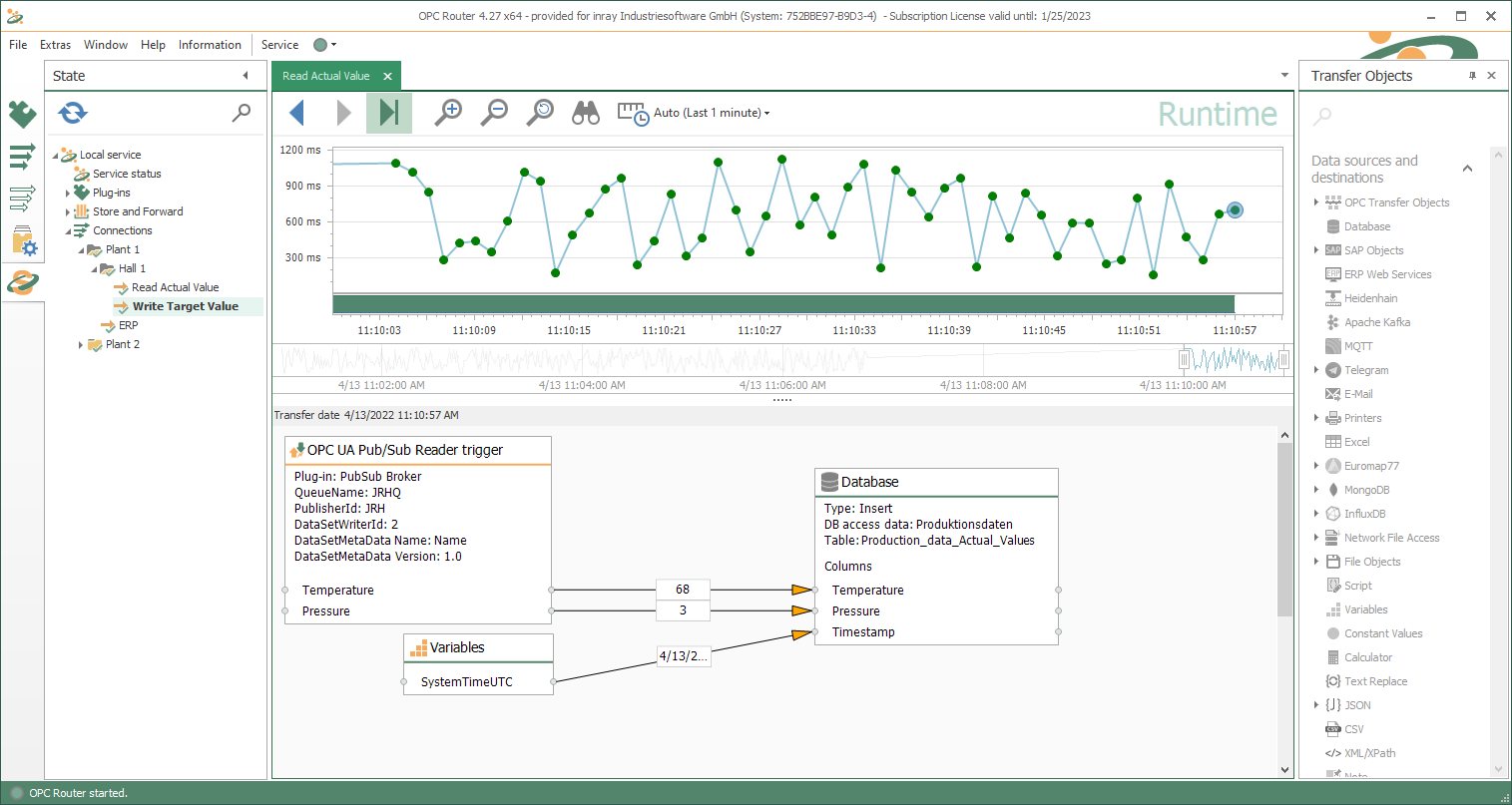The OPC UA Pub/Sub Plug-in
OPC UA Publish and Subscribe – OPC data transfer in a new way
The OPC standard has developed considerably since the first version in 1994 and has since then enabled access to automation components. The OPC Router is able to read and write data from OPC data sources. This data can then be transmitted to different systems.
With the OPC UA Pub/Sub Plug-in, the OPC Router offers a new type of communication for OPC UA data. The Pub/Sub communication works based on the Publish-and-Subscribe principle. The OPC Router is integrated into this communication. It is able to act as a Publisher (sender) and as a Subscriber (receiver) and can therefore exchange and receive information. The decoupling of sender and receiver leads to much simpler communication, as n-to-m connections are possible.
These and other customers rely on the OPC Router






It can be that simple.
OPC UA Pub/Sub connection via drag & drop
The integration of your OPC UA Pub/Sub Plug-in is very simple and intuitive with the OPC Router via drag & drop. In our screenshots you can see exemplary OPC UA Pub/Sub transfers. The transfer object OPC UA Pub/Sub Writer can send data to a connected Broker. In this example, the transfer object receives data from a database and then publishes it. The OPC UA Pub/Sub Trigger can receive data and values from the Broker and therefore acts as a Subscriber. In this example, it receives data from the Broker and stores it in the cloud together with a timestamp.
Accelerating communication with Pub/Sub
Accelerating communication with Pub/Sub
The Industrial Internet of Things provides many opportunities to use a Pub/Sub connection and simultaneously accelerate the internal communication between software and devices. Compared to a client/server application, Pub/Sub communication reduces the required connections since all connected devices and software communicate via a Broker. This reduces n-to-m connections, which decreases the processor and network load. Therefore, with Pub/Sub communication, the communication speed can be increased and the costs reduced.
- Achieving more through linked systems:
OPC ensures that a large number of devices can be addressed via a similar standard. The OPC UA Pub/Sub Plug-in extends the OPC Router by a fast and simple communication tool. - Industry 4.0 with OPC UA Pub/Sub:
The connected systems in the world of Industry 4.0 communicate via many different interfaces. The OPC UA Pub/Sub Plug-in simplifies and accelerates this communication. The OPC Router creates the necessary connection to the infrastructure of networked production. - Data hub as Publisher and Subscriber:
With the OPC Router you can graphically realise the network of your systems. With its Plug-ins, it turns into a data hub for the industrial environment. It is distinguished by simple configuration, sophisticated monitoring and reliability. With the OPC UA Pub/Sub Plug-in, the OPC Router can be operated as a Publisher and Subscriber and establish real-time OPC communication in your system structure.
OPC UA Pub/Sub Plug-in Use Cases

Recording temperature data with OPC UA Pub/Sub
In practice, Pub/Sub communication is often used for sensors. Different sensors in a facility transmit their data and values to the Broker. The Broker then distributes the data to the software and devices that have subscribed to the data. It is not necessary to have a direct connection between each receiver, due to the Pub/Sub communication. This removes the n-to-m connections without affecting the communication.
An example is a machine that sends temperature values to the Broker. An existing monitoring system has subscribed to these temperature values and therefore automatically receives the temperatures from the Broker. The system can then compare the actual temperatures with the target temperatures and react in case of deviations.
Machine data via OPC UA Pub/Sub into the cloud
A common example of industrial IoT is to store machine data in a cloud. With the help of OPC UA Pub/Sub communication, this can be achieved without complicated connections. According to the Publish-and-Subscribe principle, for example, a machine sends production data to the broker. A connected cloud, which has subscribed to all relevant production data of a plant, receives this data from the Broker now. The cloud acts as a Subscriber, processes the data and makes it available for other devices or software in the company. At the same time, the OPC Router receives the same data from the Broker, because it is subscribed to the same topic as well. In addition to the cloud, it can now inform the sales department about a completed production and start the next order.
Connecting systems with the OPC Router OPC UA Pub/Sub Plug-in
Transfer-Objects
The transfer object of the OPC UA Pub/Sub Plug-in turns the OPC Router into a Publisher. With the help of the OPC UA Pub/Sub Writer, the OPC Router is able to send individual data to a Broker. The data collected by the OPC Router is connected to the OPC UA Pub/Sub Writer via drag & drop, which then forwards the data to the Broker. All data can then be received by the connected OPC UA Pub/Sub Subscribers.
Trigger
The trigger of the OPC UA Pub/Sub Plug-in allows the OPC Router to read data in the Pub/Sub communication. Due to this, it becomes a Subscriber. The OPC UA Pub/Sub Trigger is able to subscribe to different topics at the Broker. In addition, it automatically reads which data a Publisher sends to the Broker and enables simple subscription. Whenever a data set is sent to the Broker, the trigger of the OPC UA Pub/Sub Plug-in checks whether this data set has been subscribed and collects the data if necessary.
Browsing
Browsing is provided via the OPC UA Pub/Sub Trigger. During publishing, data is transferred together with a DataSet. The trigger, in the role of the Subscriber, can take over this DataSet from the corresponding Publisher via the browsing function. This avoids the need to enter the DataSet manually.


